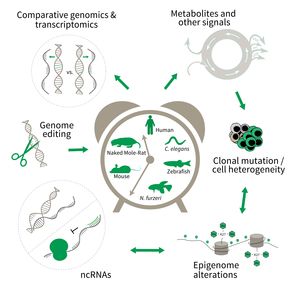Subarea 3: Genetics and Epigenetics of Aging
The focus of Subarea 3 is on genetic and epigenetic determinants of life- and health span as well as aging in fish, rodents and humans. This line of research builds on the expertise of the institute in comparative and functional genomics.
The research is defined by five focus areas:
- Comparative genomics in short- and long-lived models of aging,
- Genomic engineering in N. furzeri,
- Epigenetics of aging,
- Non-coding RNAs in aging, and
- Comparative transcriptomics of aging.
Research focus of Subarea 3.
To uncover causative factors for aging, comparative genomics in short- and long-lived model systems are applied. Functional genomics is used to identify novel pathways contribute to aging of an organism and to validate the functional relevance of genetic and epigenetic changes that occur during aging. Furthermore, genetic risk factors for aging-related diseases are identified and functionally tested. The future development of the Subarea aims to integrate changes in host-microbiota interactions during aging, and how these influence clonal mutation and epigenetic alterations through metabolites and other signals.
Publications
(since 2016)
2023
- Genome Structure, Life Cycle, and Taxonomy of Coronaviruses and the Evolution of SARS-CoV-2.
Lamkiewicz K, Esquivel Gomez LR, Kühnert D, Marz M
Curr Top Microbiol Immunol 2023, 439, 305 - Interaction between epithelial cells and immune cells in the intestine during aging
Lu J
Dissertation 2023, Jena, Germany - Analysis of different strains of the turquoise killifish Nothobranchius furzeri identifies transcriptomic signatures associated with heritable lifespan differences
Mazzetto M, Reichwald K, Kelmer Sacramento E, Koch P, Ori A, Groth M, Cellerino A
bioRxiv 2023, 10.1101/2023.11.20.567823 - Maximizing the potential of genomic and transcriptomic studies by nanopore sequencing
Meyer* D, Göttsch* W, Spannenberg* J, Bohn P, Stieber B, Krautwurst S, Höner zu Siederdissen C, Srivastava A, Zarkovic M, Wollny** D, Marz** M
bioRxiv 2023, https://doi.org/10.1101/2023.12. * equal contribution, ** co-corresponding authors - RNA-based sensitive fungal pathogen detection
Micheel** J, Aron F, Kelani AA, Girbardt C, Blango MG, Walther G, Wollny** D
bioRxiv 2023, https://www.doi.org/10.1101/2023 ** co-corresponding authors - A computational framework for testing hypotheses of the minimal mechanical requirements for cell aggregation using early annual killifish embryogenesis as a model.
Montenegro-Rojas I, Yañez G, Skog E, Guerrero-Calvo O, Andaur-Lobos M, Dolfi L, Cellerino A, Cerda M, Concha ML, Bertocchi C, Rojas NO, Ravasio A, Rudge TJ
Front Cell Dev Biol 2023, 11, 959611 - Identification of altered miRNAs and their targets in placenta accreta.
Murrieta-Coxca JM, Barth E, Fuentes-Zacarias P, Gutiérrez-Samudio RN, Groten T, Gellhaus A, Köninger A, Marz M, Markert UR, Morales-Prieto DM
Front Endocrinol (Lausanne) 2023, 14, 1021640 - Author Correction: IFNγ-Stat1 axis drives aging-associated loss of intestinal tissue homeostasis and regeneration.
Omrani* O, Krepelova* A, Rasa SMM, Sirvinskas D, Lu J, Annunziata F, Garside G, Bajwa S, Reinhardt S, Adam L, Käppel S, Ducano N, Donna D, Ori A, Oliviero S, Rudolph KL, Neri F
Nat Commun 2023, 14(1), 6302 * equal contribution - IFNγ-Stat1 axis drives aging-associated loss of intestinal tissue homeostasis and regeneration.
Omrani* O, Krepelova* A, Rasa SMM, Sirvinskas D, Lu J, Annunziata F, Garside G, Bajwa S, Reinhardt S, Adam L, Käppel S, Ducano N, Donna D, Ori A, Oliviero S, Rudolph KL, Neri F
Nat Commun 2023, 14(1), 6109 * equal contribution - The Tgf-β family member Gdf6Y determines the male sex in Nothobranchius furzeri by suppressing oogenesis-inducing genes
Richter A, Mörl H, Thielemann M, Kleemann M, Geißen R, Schwarz R, Albertz C, Koch P, Petzold A, Groth M, Hartmann N, Herpin A, Englert C
bioRxiv 2023, 10.1101/2023.05.26.542338









